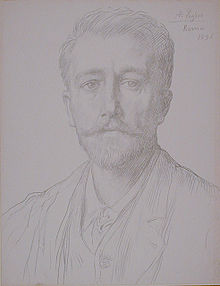- Charles Holroyd
-
 Charles Holroyd in 1896. Drawing by Alphonse Legros.
Charles Holroyd in 1896. Drawing by Alphonse Legros.
Sir Charles Holroyd (9 April 1861 – 17 November 1917) was an English artist and curator.
Contents
Biography
Early years
Charles Holroyd was born in Leeds. He received his art education under Professor Legros at the Slade School, University College, London, where he had a distinguished career.
After passing six months at Newlyn, where he painted his first picture exhibited in the Royal Academy, Fishermen Mending a Sail (1885), he obtained a travelling scholarship and studied for two years in Italy, a sojourn which greatly influenced his art.
At his return, on the invitation of Legros, he became for two years assistant-master at the Slade School, and there devoted himself to painting and etching.
Career
Among his pictures may be mentioned The Death of Torrigiano (1886), The Satyr King (1889), The Supper at Emmaus, and, perhaps his best picture, Pan and Peasants (1893).
For the church of Aveley, Essex, he painted a triptych altar-piece, The Adoration of the Shepherds, with wings representing St Michael and St Gabriel, and designed as well the window, The Resurrection. His portraits, such as that of GF Watts, RA, in the Legros manner, show much dignity and distinction.
Holroyd made his chief reputation as an etcher of exceptional ability, combining strength with delicacy, and a profound technical knowledge of the art. Among the best known are the Monte Oliveto series, the Icarus series, the Monte Subasio series, and the Eve series, together with the plates, The Flight into Egypt, The Prodigal Son, A Barn on Tadworth Common (etched in the open air), and The Storm. His etched heads of Professor Legros, Lord Courtney and Night, are admirable alike in knowledge and in likeness. His principal dry-point is The Bather.
In all his work Holroyd displays an impressive sincerity, with a fine sense of composition, and of style, allied to independent and modern feeling. He was appointed the first keeper of the National Gallery of British Art (Tate Gallery) in 1897,[1][2] and on the retirement of Sir Edward Poynter in 1906 he received the directorship of the National Gallery. He was knighted in 1903.[3] His Michael Angelo Buonarotti (London, Duckworth, 1903) is a scholarly work of real value. He died on 19 November 1917.[4]
References
- ^ London Gazette: no. 26884. p. 4677. 20 August 1897. Retrieved 2008-10-08.
- ^ London Gazette: no. 26888. p. 4944. 3 September 1897. Retrieved 2008-10-08.
- ^ London Gazette: no. 27630. p. 8563. 29 December 1903. Retrieved 2008-10-08.
- ^ London Gazette: no. 30551. p. 2659. 1 March 1918. Retrieved 2008-10-08.
 This article incorporates text from a publication now in the public domain: Chisholm, Hugh, ed (1911). Encyclopædia Britannica (11th ed.). Cambridge University Press.
This article incorporates text from a publication now in the public domain: Chisholm, Hugh, ed (1911). Encyclopædia Britannica (11th ed.). Cambridge University Press.
Further reading
- Dodgson, Campbell Sir Charles Holroyd's Etchings The Print Collector’s Quarterly 1923 Oct Vol 10, No. 3, p309.
- Dodgson, Campbell Etchings of Sir Charles Holroyd (Catalogue - partial) The Print Collector’s Quarterly 1923 Oct Vol 10, No. 3, p322.
- Dodgson, Campbell Etchings of Sir Charles Holroyd (Catalogue, continued) The Print Collector’s Quarterly 1923 Dec Vol 10, No. 4, p347
External links
 Works written by or about Charles Holroyd at Wikisource
Works written by or about Charles Holroyd at Wikisource- listing of 287 Holroyd prints, many with images artistarchive.com
Cultural offices Preceded by
Did not existDirector of the Tate Gallery
1897–1906Succeeded by
D. S. MacCollCharles Lock Eastlake (1855) · William Boxall (1866) · Frederick William Burton (1874) · Edward Poynter (1894) · Charles Holroyd (1906) · Charles Holmes (1916) · Augustus Daniel (1929) · Kenneth Clark (1934) · Philip Hendy (1946) · Martin Davies (1968) · Michael Levey (1973) · Neil MacGregor (1987) · Charles Saumarez Smith (2002) · Nicholas Penny (2008)
Tate Galleries Directors Charles Holroyd (Keeper) · D. S. MacColl (Keeper) · Charles Aitken · J. B. Manson · John Rothenstein · Norman Reid · Alan Bowness · Nicholas SerotaBenefactors Exhibitions Turner Prize (2006) (2007) (2008) (2009) (2010) · List of Turner Prize winners and nominees · The Weather Project · Embankment · Test Site · ShibbolethOther Categories:- 1861 births
- 1917 deaths
- English painters
- English curators
- Knights Bachelor
- People from Leeds
- Artists from London
- Directors of the National Gallery, London
Wikimedia Foundation. 2010.
